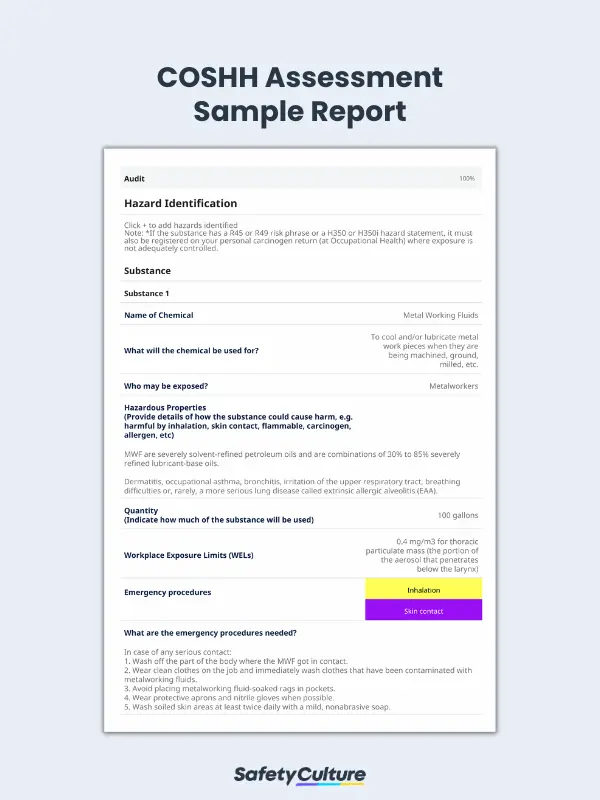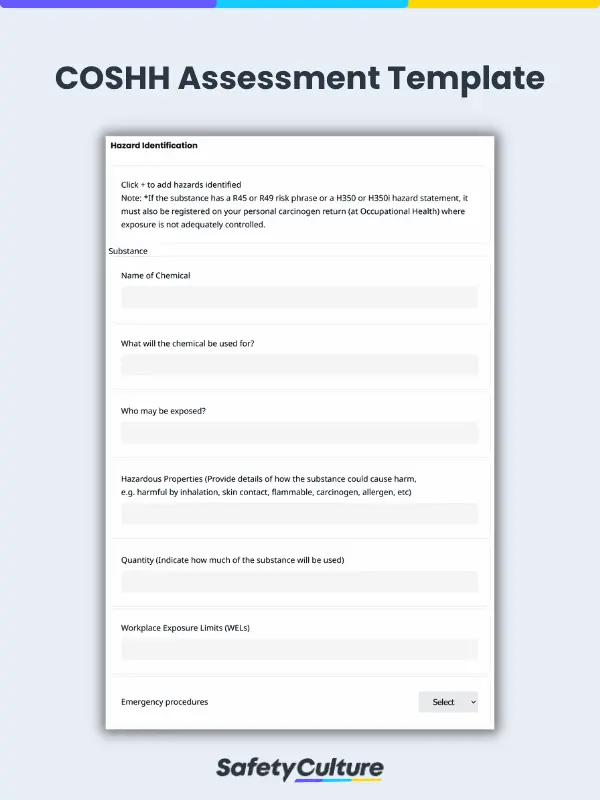What is a COSHH Assessment Template?
A COSHH (Control of Substances Hazardous to Health) assessment template is a tool that provides businesses with a framework for conducting COSHH assessments. This template allows them to identify hazardous substances present in their operations, evaluate the risks associated with them, and establish control measures to manage these risks.
What is a COSHH Assessment?
A COSHH (Control of Substances Hazardous to Health) Assessment, or COSHH Risk Assessment, is a health and safety evaluation process and document often used with COSHH registers. It aims to identify and evaluate hazards and risks from hazardous substances used in the workplace or produced during operational processes and devise control measures to reduce or eliminate identified risks.
The UK’s Health and Safety Executive (HSE) requires a COSHH assessment as a standard safety measure to protect employees from harmful substances and avoid adverse health effects.
Why Should You Perform This Process?
Exposure to chemical substances is a common occupational hazard. An HSE report found 6,000 self-reported cases of skin disease from 2015 to 2018 due to hazardous substance exposure. Skin disease from chemical exposure has profound detrimental effects on workers’ daily activities, ability to work, and self-image. Occupations most affected include metalworkers, machine operators, and other industrial workers dealing with hazardous substances. Performing COSHH assessments can ensure a safer workspace that can help boost employee productivity and morale.
Advantages of Using a Template for COSHH Assessments
COSHH assessments are crucial for identifying hazards associated with hazardous substances. This audit can, however, be time-consuming and complex if you lack the necessary expertise and knowledge. In those situations, a COSHH assessment template can be incredibly useful.
Using a COSHH assessment template can help you:
- Save time – With a template, you no longer have to spend hours creating a new file from scratch, as it already covers the necessary information and sections for a COSHH assessment. Instead, you simply need to record the specific details about your workplace and the hazardous substances you use or handle.
- Improve accuracy – Apart from speeding up the process, using a template also reduces the risk of overlooking crucial information or sections in the assessment. Throughout this document, prompts or questions help you identify all potential hazards, ensuring that all sections are completed as required.
- Ensure consistency – The standardized format of these templates creates a structure for COSHH assessments, making them more systematic and organized. This way, it becomes easier to determine anything that stands out or common themes/trends across assessments.
5 Essential Elements of a COSHH Assessment Template
An efficient COSHH assessment should document these 5 essential elements:
- Detailed listing of hazardous substances present in the workplace
- Workplace Exposure Limits (WELs) and health risks
- Control measures to be implemented (PPE, First Aid Measures)
- Information on proper storage, handling, and disposal of chemicals
- Authorization by employer or supervisor
How to Use This Template
Using a COSHH assessment template is easy once you have your template ready. Below is a step-by-step guide:
1. Identify existing hazardous substances.
Start filling out the COSHH assessment template by identifying all hazardous substances at work, such as chemicals, dust, fumes, and biological agents. Even small amounts of hazardous materials pose a threat, so it is crucial to identify them comprehensively.
2. Assess the risks.
After identifying all hazardous substances, the next step is evaluating their risks. This involves considering factors like potential exposure, toxicity, and likelihood of harm associated with each substance. Apart from considering the work being done by workers, the assessment should also look at their specific tasks and activities, since these can affect the risk level.
3. Implement controls.
Using the results of the risk assessment, the team can develop and implement controls to manage or eliminate the identified risks, such as but not limited to:
- Using personal protective equipment (PPE)
- Changing work practices or procedures
- Modifying the physical environment
4. Review and revise.
Lastly, COSHH assessments are not one-off events. Therefore, they must be reviewed and revised regularly to ensure they remain valid and effective. These revisions can happen due to new hazardous substances in the workplace or changes in work procedures.
COSHH Assessment Example
Now that you know how to use a template for COSHH assessments, it’s time to put that knowledge into practice. The COSHH form example below shows how a hazardous substance can be identified, controlled, and evaluated in a systematic manner:
| Step 1: Hazard Identification | |
| Chemical name | Metalworking fluids (MWFs) |
| What will the chemical be used for? | To cool and/or lubricate metalwork pieces when they are being machined, ground, milled, etc. |
| Who may be exposed? | Metalworkers |
| Hazardous properties (How could the substance cause harm? E.g., inhalation, skin contact, flammability, carcinogen, allergen) | MWFs are severely solvent-refined petroleum oils and are combinations of 30% to 85% severely refined lubricant-base oils.
Dermatitis, occupational asthma, bronchitis, irritation of the upper respiratory tract, breathing difficulties, or, rarely, a more serious lung disease called extrinsic allergic alveolitis (EAA). |
| Quantity (How much of the substance will be used?) | 100 gallons |
| Workplace Exposure Limits (WELs) | 0.4 mg/m3 for thoracic particulate mass (the portion of the aerosol that penetrates below the larynx) |
| Emergency procedures for: | Inhalation, skin contact |
| What are emergency procedures needed? | In case of any serious contact:
|
| Step 2: Methods of Prevention or Control of Exposure | |
| Engineering controls required | Total containment, Fume cupboard, Local exhaust ventilation |
| Access control | Restricted to competent personnel |
| Special procedures | SOP, Code of Practice, local rules, etc. |
| Approved PPE | Gloves, Eye protection, Laboratory coat |
| Disposal Procedures |
|
| Are chemicals with risk phrases R50-R59 or hazard statements H400 – H413 (environmental hazards) involved? | Yes |
| Training Requirements | To be planned next week. |
| Handling and Storage Requirements | Needs to be coordinated with the responsible team. |
| Step 3: Assessment of Risk Using Controls Detailed Above | |
| Are the hazards/risks suitably controlled, using the control measures detailed above? | Yes |
For a full view of this example, check this sample COSHH assessment report in PDF format.
FAQs About COSHH Assessment
While COSHH assessment specifically focuses on the risks associated with hazardous substances such as chemicals, a risk assessment is a more general process that identifies and evaluates potential hazards in the workplace. In other words, COSHH assessments can essentially be classified as a type of risk assessment aiming to eliminate workplace risks.
The HSE doesn’t specify any qualifications for those who conduct COSHH inspections or assessments. However, the person must possess the necessary knowledge, training, and expertise to carry out this process in line with COSHH guidelines. They should be able to identify the hazards, assess the risks, and recommend appropriate control measures.
Several factors can trigger a COSHH assessment, such as changes in the hazardous substances being used, modifications in how the substances are handled, the introduction of new work processes or equipment, or specific incidents involving hazardous substances.
COSHH assessments should be completed in cases where hazardous substances are likely or already present in the workplace. Examples of these situations include:
- Introduction of new substances
- Changes in processes or procedures
- Accidents, hazards, or near-misses
These assessments must also be reviewed regularly to reflect the most recent procedures and workflows in the organization.
As a guideline, it is recommended that COSHH assessments are reviewed at least once every 12 months. However, if there’s an incident or significant change that can impact how substances are handled, they should be reviewed immediately to ensure they remain up-to-date and effective.
COSHH encompasses most substances that pose health and safety hazards to workers. These include materials that could lead to skin, respiratory, and other health issues, such as the following:
- Chemicals – solvents, acids, corrosive substances, pesticides, cleaning agents
- Respiratory hazards – dust, fumes, gases, vapors
- Carcinogens – substances that could increase the risk of occupational cancer
- Nanomaterials – exposure to dangerous microparticles
- Biological agents – harmful bacteria, viruses, fungi, and other microorganisms that could induce infections, illnesses, and other health hazards
Lead, asbestos, and radioactive materials fall outside the scope of COSHH. Safety officers can instead refer to the following regulations specifically designed for these substances:
- Lead – Control of Lead at Work Regulations 2002
- Asbestos – Control of Asbestos Regulations 2012
- Radioactive substances – Radioactive Substances Act 1993




